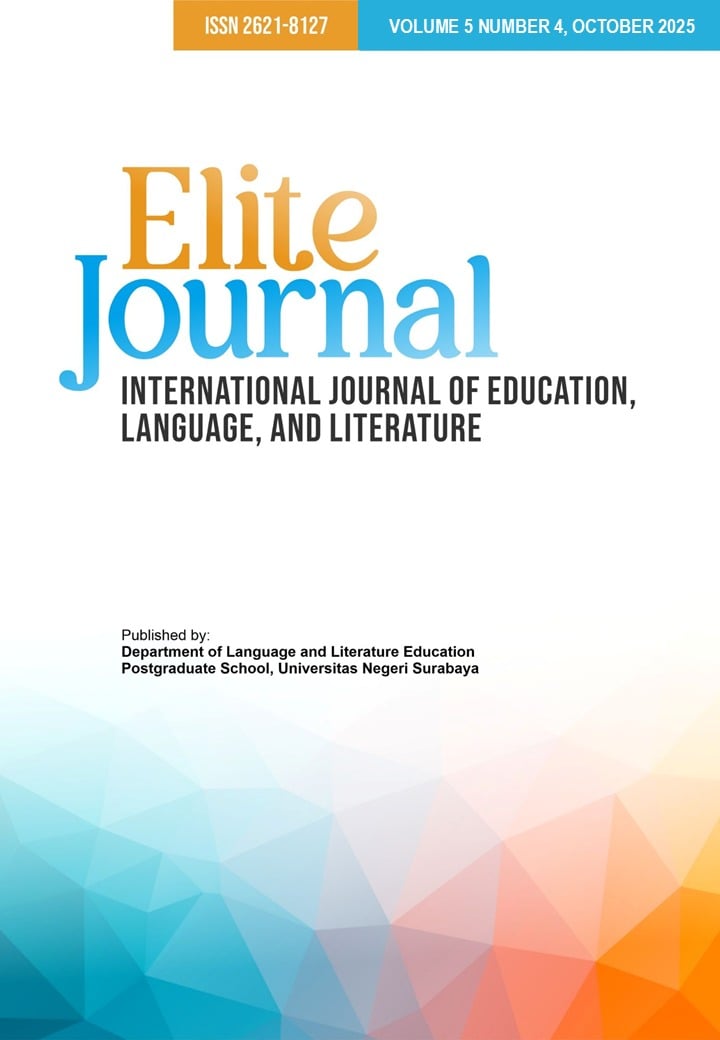ISOLATION AND IDENTITY IN DICKINSON: A PSYCHOANALYTIC APPROACH
DOI:
https://doi.org/10.26740/elitejournal.v5n4.p32-36Keywords:
Ego, Emily Dickinson, Freud, Identity, PsychoanalysisAbstract
This study examines Emily Dickinson’s poem The Soul Selects Her Society through a Freudian psychoanalytic lens, with particular focus on the portrayal of identity. Using Sigmund Freud’s structural model of the psyche, the id, ego, and superego, this research investigates how the soul’s selective withdrawal functions as a defense mechanism for preserving selfhood. The analysis interprets the poem not as a mere act of social retreat but as a conscious assertion of individuality, in which the ego regulates instinctual desires and resists external pressures. Findings reveal that the soul’s rejection of societal appeals reflects the ego’s effort to maintain psychological boundaries, safeguard authenticity, and establish identity. Connections to Dickinson’s reclusive lifestyle and poetic style further demonstrate how her personal life resonates with this act of inward loyalty. Ultimately, the poem emerges as a literary articulation of the psyche’s negotiation of selfhood, showing identity as an active construction achieved through autonomy, resistance, and self-protection.
References
Arindi Kusumaningrum, D., & Yastanti, U. (2023). Imagery and figurative language in Emily Dickinson’s poems. English Journal Antartika, 1(1). Retrieved from https://ejournal.mediaantartika.id/index.php/eja/index
Butler, J. (1990). Gender trouble: Feminism and the subversion of identity. New York, NY: Routledge.
Cherry, K. (2023). Id, ego, and superego: The Freudian theory of personality. Verywell Mind. Retrieved from https://www.verywellmind.com/the-id-ego-and-superego-2795951
Davis, R. (2022, September 5). When Emily Dickinson mailed it in. The New Yorker. Retrieved from https://www.newyorker.com/books/under-review/when-emily-dickinson-mailed-it-in
Dickinson, O. E. (2011). I’m nobody, who are you? A psychoanalytical approach to the poetry of Emily Dickinson. [Unpublished thesis].
Doost, N. Z., & Jamili, L. B. (2014). Actualizing identity, self-actualization in Emily Dickinson’s poetry. Journal of Language, Literature and Culture Studies, April, 337–343.
Francis, N. H., & Kritsonis, W. A. (2006). A brief analysis of Abraham Maslow’s original writing of “Self-actualizing people: A study of psychological health.” Doctoral Forum: National Journal of Publishing and Mentoring Doctoral Student Research, 3(1), 1–7.
Gilbert, S. M., & Gubar, S. (1979). The madwoman in the attic: The woman writer and the nineteenth-century literary imagination. New Haven, CT: Yale University Press.
McLeod, S. (2023). The psyche: Id, ego and superego. Simply Psychology. Retrieved from https://www.simplypsychology.org/psyche.html
Philosophy Nest. (n.d.). Understanding Jacques Lacan’s psychoanalysis theories. Retrieved from https://philosophynest.com/details-5388000-understanding-jacques-lacans-psychoanalysis-theories.html
Pillay, I. P. (n.d.). “Could it be madness—this?”: Bipolar disorder and the art of containment in the poetry of Emily Dickinson. Journal of Medical Humanities Studies.
Pollack, V. R. (2004). A historical guide to Emily Dickinson. New York, NY: Oxford University Press.
Smith, M. (2023, March 6). The master letters of Margaret Fuller and Emily Dickinson. The New Yorker. Retrieved from https://www.newyorker.com/books/page-turner/the-master-letters-of-margaret-fuller-and-emily-dickinson
Vendler, H. (1988). The music of what happens: Poems, poets, critics. Cambridge, MA: Harvard University Press.
Vendler, H. H. (2004). Poets thinking: Pope, Whitman, Dickinson, Yeats. Cambridge, MA: Harvard University Press.
White, F. D. (2008). Approaching Emily Dickinson: Critical currents and crosscurrents since 1960. Cambridge, UK: Cambridge University Press.
Zhou, F. (2023). Exploring the nature of life in Emily Dickinson’s poems. International Journal of Education and Humanities, 9(1), 48–50. https://doi.org/10.54097/ijeh.v9i1.9154
Downloads
Published
How to Cite
Issue
Section
License
Copyright (c) 2025 Yohana Engelina Manurak Manu

This work is licensed under a Creative Commons Attribution 4.0 International License.
 Abstract views: 61
,
Abstract views: 61
, PDF Downloads: 29
PDF Downloads: 29





